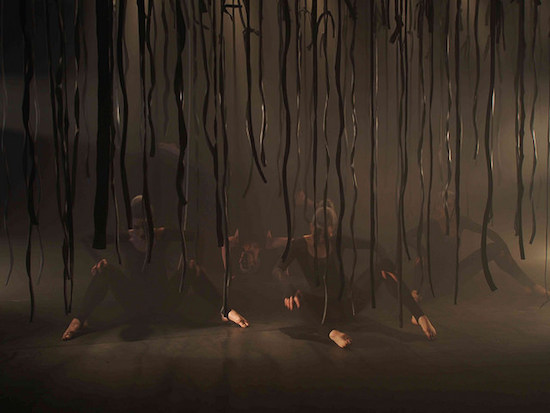At the end of the Second World War, the area around Berlin’s Hebel Am Ufer theatre was a wasteland of broken rubble and destruction. The residents of Berlin, starved of art by the Nazis and final grim months of conflict, flocked to the emerging post-war theatre scene, sometimes exchanging lumps of coal for tickets. In an age of artistic commodification such visceral and mass-consumed embracing of the arts is surely hard to find. Festivals like CTM allow the cognescenti to de-programme themselves from the bright but empty blur of corporate mass culture, but where does that leave the rest? This year’s CTM theme is Un Tune, explained poetically thus: "exploring the affective potential of sound from innumerable points of view: spatial explorations, otoacoustic emissions, binaural beats, and other phenomena that play on our perception and mental states meet visceral manifestations such as acerbic grindcore hallucinations, psychedelic drone freakouts, numbing consumer-trash beats, and future-punk ecstasies." Sound certainly has the power to knock us out of the habitual, yet as the mainstream and fringe cultures move further apart, so it becomes more difficult for these extreme sounds to reach the mass audience where they might have the most effect. The mass audience in turn, through this distance are all the more ready to dismiss most of what might be encountered at CTM as "just noise", challenging, but in a way prosaically so. Can underground explosions be heard? Luke Turner
Health and safety be damned
The opening night event of CTM is possibly the only concert I’ve been to in recent years where the festival programmer warns that the frequencies generated will create an illusionary sound in the ears, which will make some want to put in earplugs. Please don’t, we are told, for this will take away the entire point of the performance. Thomas Ankersmit wears a grey shirt and sits in front of a mixing desk, laptop and modular synth. A shrill sound like the insects of a forest at night, broken into by hisses and booms, and then a high pitched sound that yes is fairly unpleasant, like God’s tinnitus caused by all the smiting and shrilly pleasing condemned souls. A single light tube starts flashing on the back of the stage, joined by more. I start to feel a little queasy, half expecting some booming voice to ask me questions the answers of which I cannot possibly know. Looking round, remarkably few people have fingers stuck in ears. Ankersmit wiggles his head from side to side as he teases another seizure from his synth, which makes things rather creepy. We’re offered respite in the form of a deep thrum as if some giant container ship were passing in the night, a rattling that could be created by Ankersmit but equally might be some of the theatre’s fixtures and fittings trembling loose. Later it chugs rhythmically, like raving in the cab of Sir Nigel Gresley’s Mallard at cruising speed, before the infernal whine starts up again. Luke Turner
There are graceful ways of avoiding nostalgia
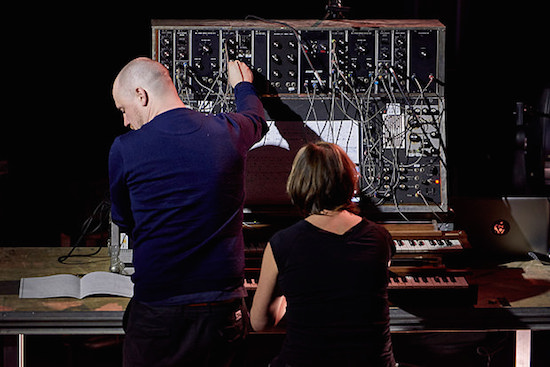
Fetishism of modular synths has reached a peak in recent years, with all sorts of spods lined up in front of the big blocks looking like they’re connecting telephone calls in a film noir. So often, though, it’s hard to work out why they’ve bothered to risk an expensive bit of gear against the chuck-happy baggage handlers of the world’s airports.
Before Ankersmit on the opening night, Rose Kallal and Mark Pilkington use modular synths and the occasional piece of sampled evil make a very physical, unctious noise, Sci-Fi rattles and whorls, a Tangerine Nightmare in front of film projections, squares of light and colour – that shade of orange particular to the 70s.
Nan Goldin’s collaboration with the Soundwalk Collective that follows is a thoughtful, moving piece. An orange yellow street lamp glows in the screen, ringed like Jupiter. A hum, a whoosh as metal is spun around the edge of a cymbal. "I feel a vague nausea…" says Nan Goldin, reading from the writings of David Wojnarowicz, the poet who died of AIDS in 1992. "Destination means death to me." Too often the pioneering spirit of countercultural art movements fade into nostalgia, used as a signifier on the interests section of dating websites, ossified into expensive monographs, rendered mundane by endlessly gabbling talking-head turkeys. "I grew up in a tiny version of hell called the suburbs" she talks calmly of familial abuse and violence, and a clapperboard house appears on the screen behind the musicians. "Where evil dwells" is written on a sheet of glass in front of this all-American view.
The freeform but subtly intense musical backing makes this contemporary and relevant. Those suburban lawns are still tended, and unspeakable things still happen behind those freshly painted doors. A meditation on death and survival sees a groove gradually emerge: "I want relief from this yap yapping of my brain. I wish I could pluck it out and leave it in the corner, while I go out for the evening. "Goldin makes notes throughout, her pen bringing these words into this moment, and it closes with the reading of a passage of redemption, of coming to terms with individual suffering at the hands of family or state, and a fulsome description of a gay encounter in an hotel room . The final words are of acceptance, positive even: "Smell the flowers while you can" on the screen, a school globe spins.
Tuesday night is my first time in Berghain, and the huge space quiet with an air of expectation, something like a cathedral before evensong. This is, after all, something of a sacred space. But at whose feet do we kneel? Onstage is an ancient machine that looks like something that might once have controlled a space like this. It is the Höllenmaschine, a kind of Ur-Modular born in 1957 that took a decade to build. Its name translates, appropriately enough, as ‘hell machine’. Manon Liu Winter plays fast sequences of notes on the same section of the keyboard, with an assistant on hand to do the patching. It’s a deranged and heady sound, spinning like an ancient fairground Wurlitzer comandeered by dark angels letting their flaming hair down while dour old Beelzebub is away negotiating the transfer of souls with St. Peter. Luke Turner
"It is not in what we share but in what we cannot fully share that the value of such experience lies"
"Just as our bodies are structurally similar and yet differ widely in their actual constitutions, people experience frequencies, sound, noises music and the interaction of these phenomena with other sensory input in similar and yet very different ways." So writes festival founding member Jan Rohlf in the forward to the official CTM magazine, pressed into my hands on arrival at the ticket desk in Berlin’s Kunstquartier Bethanien, a former hospital situated in East Kreuzberg that looms peculiarly over nearby apartment blocks. It’s a statement that continuously weaves its way between its editorial, cropping up repeatedly in the essays and interviews printed upon its pages. I’m not entirely sure I entirely agree with the sentiment myself, my own personal addendum would be that while experience can actually often be simultaneous, it is more the act of reaction that is encountered in more intriguing opposing ways, influenced by exterior context: comfort levels, chemical and alcoholic imbalance, present company, time of day, to name but a few. Regardless, it’s something that plays across my mind over the course of my days in Berlin.
Powell’s excellent early Saturday morning live set evokes mixed responses from the CTM crowd; while myself and others lose themselves to frantic percussion, others stand more meditatively, looking somewhat unsure what to do with themselves. Others flinch, as if fighting the will to move. Others kiss, others stare, others cane cigarettes in darkened corners. Oscar Powell himself towers before the controls, smothering track into track between bridges of distortion, raising a hand, palm forward, twitching in time to the stutters of sexually charged static. While much of the music I find myself in clubs for is, though brilliant, often very linear and relatively physically unchallenging, Powell’s calls for constant concentration and deliberation. Become complacent for a moment and you find yourself falling embarrassingly out of time, impaling yourself on a palisade of noise, or accidentally dancing like a maniac to the minimal "heys" on ‘No U Turn’. As such, his set is both physically and mentally exhausting. It’ll still leave you with a massive grin plastered across your face though.
It’s difficult to initially determine the varying personal experiences of Jenny Hval and Susanna’s performance – a beginning to end concert recital of their excellent Meshes Of Voice LP from last year on Saturday evening – not least until hearing the degrees of discussion from those gathered in the lobby of HAU1 afterwards. They perform alongside a keyboard and tuba player who emits the most curious of noises from her instrument, standing before a screen of shuddering visuals that bring to mind old Windows screen savers. The juxtapositioning of light and dark is even more staggering live than on record, thunder pierced by piano chords, Hval’s vocals rising high above the low rumble of drones, and in turn with Susanna’s own voice. It’s tempestuous and tumultuous, sailing through a journey of mythical illusions, static feedback and cyclical patterns that whoosh between refrains of words, coming and going between sharp intakes of breath. Sophie Coletta
"It’s the sense of human touch that gives a celebration"
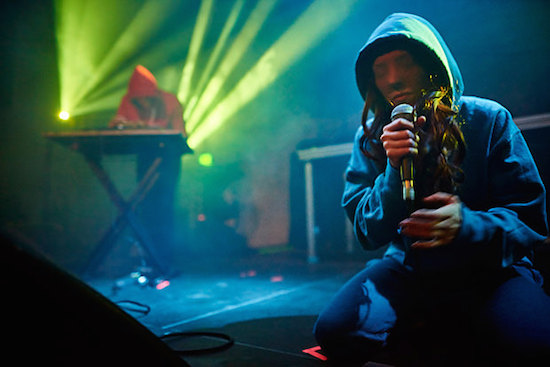
The first thing you about Gazelle Twin is that she looks amazing. After five nights of mostly men (albeit one with a spaghetti head) nodding away, this blue hooded and faceless form, false hair vomiting forth, weaving on the stage makes for such wonderful theatre. For all the talk of music’s effect on the body over CTM’s theme, it can feel rather abstractly theoretical, but this character on the stage in front of us is an untuning from self in order to defeat the insecurities that, however superficially petty, hold so many of us back. She’s entirely commanding, even when you can’t see her as she squats singing, "take after me take after me", in part because the clarity of the system means that the voice is spectral and all around us.
The voice-as-rhythm gasps of ‘Belly Of The Beast’ are like having your ears sandpapered, ‘Unflesh’ builds as harsh as JK Flesh. What I love about Gazelle Twin is her ability to muddle around, through music and sound alone, with one’s own sense of gender identity, should you want it to. We’ve the Kinsey scale of human sexuality, along which it’s liberating to play a variety of notes. But why does gender have to be defined by such polarities – male female or alternately travelling trans*? Can gender not be fluid, and move with time? It’s all very well to play with this as an aesthetic, as pop has always done, but there’s a generosity to Gazelle Twin that’s an invitation to untune the audience’s own flesh. Luke Turner
Euro goths 1 – Digi-LOL 0
Shortly before Oake’s set, a string of young Berliners weave through the audience, hand in hand. Two of them have perfect deep black oblongs painted on their faces. Their clothes are monochrome and subtly revealing, their hair Ancien Regime. The stage is hung with tens of stands of material, knotted in the middle, stretching from ceiling to floor, at the edges mannequin hands and heads are woven in. Orange light flashes through them, like dawn through the trunks of a winter forest, then strobes and the previously-spotted lithe youth are writhing around on the floor. The slight issue is that all the floorwork means it’s pretty much impossible to see what’s going on through the crowd, though the glimpses of moving forms through the foreground of the audience rather adds to the air of mystery and occasion. It also feels unplaceable, neither club nor noise music, gig nor theatre. Oake don’t really sound like too much else either, though it occurs to me halfway through that perhaps the closest comparison might be Norway’s similarly evocatively birch forested folk group Wardruna. Towards the end, the figures attempt to climb themselves up the wall.
It’s a bold and compelling performance. Talk of shirtless drummers with gold chains, keytars and other forms of fannying around keep tQ in the gothic room, where despite the UV Lighting nothing is glowing except my dandruff. OAKE’s Downwards compadres Grebenstein judder cavernous base and Arctic outpost guitars to a room becoming inappropriately hot thanks to four gigantic electronic bars in the ceiling, industrial sized versions of those string pull-operated bathroom heaters that everyone had in the 80s, and which always smelled of burning dust. Their music is slow and thick, an oozing dubbed out industrial.
The two groups are part of the CTM-affiliated Berlin Current project that aims to give less commercial artists from the city exposure and, given the sort of West London ukelele dub fusion yah music we’d no doubt get if London did similar.
It’s also pleasing to see that Zamilska seems to have a far more intrigued and committed crowd than Alvin & The Chipmunks sex pest SOPHIE (I have used that description before, but there’s really no better way of describing this shrill nonsense). In the interests of criticism I subject myself to this for as long as I can. The trouble with this, what I like to call Mothercare EDM it’s OK to like and its daft lyricism ("let me be your kitty cat") is this is just a fashionably acceptable sliced veneer of everything that right minded people who care about the political state of things surely ought want to tune out of. Irony can’t defeat capital, worse, it’s the slave. Luke Turner
Electric Wizard do a fine Songs Of Praise
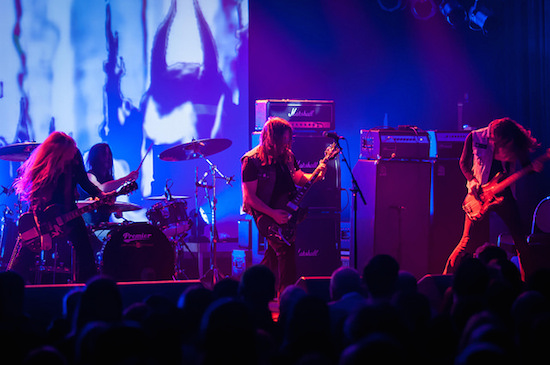
If there’s a complaint to be made about European art festivals it’s that they all-too-frequently forget the metal, which is why it’s a pleasure to see Electric Wizard flattening the Astra Club on a very unholy Sunday night. Their riffs roar forth in wondrous union, like being in the midst of synchronised sawing in the world’s biggest logging camp. They play coated in a projection from some 70s sexploitation film, a woman tied to a beam dominated by another wielding a brush. "Black mass black mass black mass" Jus Oborne shrieks before the band piledrive forth which, combined with the muck on the screen behind them, rather plays havoc with one’s note taking. Electric Wizard’s formula is basic and repetitive – a luge of guitar riffs, Oborne’s anguished screaming, a phasing and hectic breakdown that’s genuinely devil-taking-a-piss-on-the-fringes-of-your-psyche psychedelic but it works – there are, after all, innumerable ways to make the missionary position exciting. ‘Satanic Rites Of Jugula’ stretches out cruelly, as if being dragged in half between two whipped cart horses. "A chosen few are going to be dead… We’re all Lucifer’s slaves in the end." Luke Turner
Oh! To be lost at sea
A Kevin Martin silhouette – cap, hoody, beard – emerges in front of twelve orange spots though billows of dry ice – we have been promised foghorns after all. The Bug has always been a master of creeping dread, and here the prospect of the unleashed power of his own gigantic soundsystem between the right hand stacks of the Berghain’s Funktion One has people rather giddy in expectation of a pure and brutal basting. To voluntarily submit yourself to extremes is of course not masochism in the simplistic definition of the word (and masochism is obviously all about pleasure) but it’s interesting to see how his exploration of power works in a human dimension without the vocal foils of his allies and comrade MCs. Of course at the root of it The Bug is all about soul, an intelligent and thoughtful response to both the peaks and troughs of, to borrow that phrase so keenly read in brochures by the property developer bastards ruining the London that Martin recently left, Contemporary Urban Living. So when he does unleash the absolutely tremendous and awesome – a word I never use its been so ruined of late – foghorn blasts and my buttocks tremble against the security barrier I’m crushed on and my coat lifts half a centimetre off my shoulders, the hairs on the back of the neck stand up from joy as much as sonic vibration. He’s there nodding away against the bright lights, treating these blasts in exactly the same way as he might a dubplate. It’s all a bit like the horns in Brave New World.
With the bright lights onto the crowd you can look around and spot the different reactions that this crushing sound is provoking. One man has his face screwed up and nodding at at least four times the mastodon trot BPM. Others grin. A few look bemused. Another’s lips keep twitching. People stare up at the architecture, as if these industrial sounds are in some ways making them more connected to it. It all seems to heat the air, gently cooking us with vibrations like an analogue microwave. Imagine Tim Hecker if he burned the critical theory text books, ran around naked in the flames, especially when out of the dirge comes a rhythm with beats as crisp as snapping dry catacomb limbs. The Martin rig starts kicking out one of the lowest basslines I’ve ever heard. Then there’s even a synth line, or perhaps a manipulated siren, reedy and thin, as the beats get more clattery and rough. All around people are trying to dance, as much as you can when rammed in like this and sharing the vibrations. A couple just in front stare at each other, and kiss. For all the stacks of speakers and aesthetically satisfying concrete and towers of Funktion Ones and sounds from giant machines that warn of impending doom and ruin, what Kevin Martin has done tonight is reached out with vibrations and given Berghain a massive hug. Luke Turner
Forcible untuning is pure pleasure
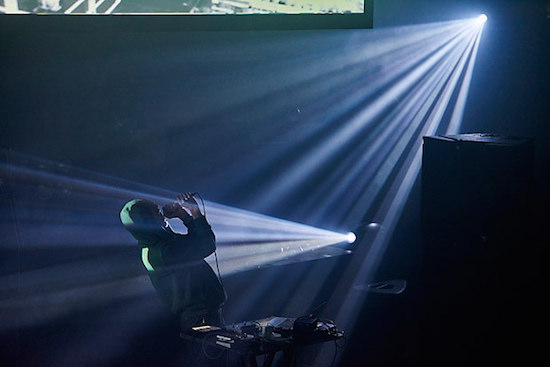
How do you follow The Bug? By punching. By slicing. An echo of The Bug’s deep booms follows on as at the start of JK Flesh’s set film of oil train through snow fills the screen and he leaps around in a green hoodie hood up, screaming into a microphone. He makes his voice sound like steel. There’s a visible slight delay from when he’s articulated his vocal sound, and when it pours out of the speakers, its a furnace blast opening up onto Siberia. This is snide, sliding down mountain scree on a metal sheet, not knowing where gravity will drop you off, beats that pop lustily like lanced boils, all over the place and a variety of tortures, dub with steel claws, laceration techno, dubstepping on a landmine, a hammer and tongs metal aesthetic applied to electronic music. A couple of days before, Mondkopf’s Extreme Precautions project is satisfyingly histrionic and pompous, synths that glow like the jewel encrusted penthouse of a future space dictator; he screams like the tyrant being pitched from it into the void when the inevitable rising happens. Luke Turner
Sound is bigger than place/space
On Wednesday night three artists use Berghain to explore music inspired, sometimes directly, by place. Klara Lewis masters this giant space as she does the smaller venues I’ve previously seen her in by virtue of subtle minimalism – tones and drones and moments of fractured conversation. There’s something about it that is if not the intensity of a lament, then a quiet and perhaps ambivalent acceptance that communication is about the transmission of both darkness and light. Her final piece has a beautifully hypnotic quality, that reminds me of childhood drives over the Pennines on the M62 back from the Blackpool illuminations, the darkness outside punctuated by the orange motorway lights. I’d count the baked beans until I’d fall asleep. Lewis builds the track not through extravagance but an occasional clang, a knell.
I half wish Lawrence English had decided to do what he did in a Quietus Q&A earlier in the day and request that everyone would just be silent and listen. Friends who’ve only been to Berghain for club nights remark on the strange quiet of the place before the music begins at these CTM gigs, and perhaps to deliberately introduce a communal experience of listening to the building might have made for an interesting staging post to what English does next. He folds what must be a field recording of wind or waves or breathing onto a growing roar, like diggers with buckets the size of bungalow shifting minerals in a gravel pit. In the end perhaps the experiment is conducted, as he draws everything down so far that there’s just a bit of a pulse audible from the PA, drowned out almost by the clatter of tripped over plastics and the chatter from the bar next door.
The new Atari Teenage Riot album is as Atari Teenage Riot albums are and probably always will and should be – a fierce and righteous awkward rock against the powerful river of all that’s from a certain perspective going wrong. But you don’t get to be so solid a rock without deep roots, as legions of bankrupt agit groups washed away downstream will attest. For Alec Empire, this rootedness seems to be from a curiosity for sound beyond DHR, and tonight he plays a set based on his Low On Ice LP, recorded in solitude in Iceland during ATR burnout in the mid-90s. These are tweaky Plastikman burbles, deep water trip hop with lunges from subterranean vents and, like English and Lewis before, take the Berghain away to strange and imaginary lands. Luke Turner
There should be more prayer at music festivals

The rattle and racket of CTM is punctuated on Wednesday night by a vocal performance of early Christian chant by Iegor Reznikoff. He introduces his unaccompanied chants by telling us that he would rather we didn’t applaud at the end as this is a piece of prayer and intimate worship. These are ancient pieces, first sung between the 4th to 6th centuries, and subsequently recorded on manuscripts. He sings Rachel’s Lament for the memory of those who died in Auschwitz, and finishes with a piece of his own composition that uses strange high tones atop the traditional arrangements. It’s one of the strangest, most transportive pieces of the entire festival, and much of the audience – including myself – is lost in exactly the sort of trance that Professor Till described in the same room earlier in the day. Reznikoff, in his gentle speaking voice, bids farewell and wishes us "singing dreams".
Broken moments are sometimes the best
Peder Mannerfelt wears a thick-stranded wig that pours forth over his head and face as if someone had dropped a large spot of spaghetti over him. He deals in regulated pulses, one part where a computer vocal is saying – I think – "hands control arms" squashed around load of noise that might be an old house tune that once fell to bits in the Berghain rafters and is now only falling down around our ears. It’s rebuilt by an ion cannon pulse and rising static, Mannerfelt shaking his spaghetti as a beat develops. It seems apt that another fractured piece of spoken word seems to refer to something under construction. There’s a lot of music around at the moment that references shattered and recontextualised histories of electronic music – see also Lorenzo Senni’s deliriously chopped up trance at HAU2 on Saturday night, a gleeful messing with the spirit of the form, rather than the technicalities. Luke Turner
None of this is anything new
On Wednesday, as part of CTM’s impressive programme of talks, Professor Rupert Till of Huddersfield University gives a lecture that looks at parallels between the cave paintings, ancient music, and contemporary club culture. Professor Till explains that our first inventions were fire and shelter, but music and the use of sound were fundamental to the further development of knowledge. "It’s OK to invent fire and the wheel but unless you pass that on to other generations these are useless." One of the reasons humans out-competed the Neanderthals was that humans created bigger social communities which allowed for the spreading of knowledge. How do you keep the large group together? Music and dance form social bonds, becoming more ritualised and going into deep states via shared experience. "Music making is a communal technology. The community that sings and dances together stays together".
We’re shown 40,000-year-old flutes made of bones, all of which were found in caves. The popular concept of a ‘cave man’ is something of a falsehood, we’re told. People lived near the entrance of the cave, not near the back as it was dark and making lamps was difficult and they only shone for around a metre around. People wary of the deeper caves, but that’s where you find the paintings and, crucially, can hear reverberation, which of course didn’t exist in an age before buildings. Till and fellow scientists did research and experiments that found that cave paintings are often found in parts of caves that have the most reverb, while simple percussion were made by snapping off stalagmites, water drops would made them ring so that the cave would essentially be playing its own song.
To make his comparison of the ancient and modern, Till talks us through ecstatic trance – sitting still, silence or soft sounds, no crisis, sensory deprivation, psychotropic drugs and having a meditative experience versus possession trance – movement, music, noise, amnesia, sensory over-stimulation, no hallucination and a crisis to go through before you enter trance. Rave nerves are ancient! Till believes that Western cultures have actually gone against the creation of trance via these enjoyable pursuits by making them illegal. He concludes by asking if this puts our continued collective experience at risk. The lesson is clear – if humanity is going to continue to compete with the cockroaches we need to rave harder. And possibly make it compulsory for politicians.
Luke Turner
Bodies are an important construct of a performance
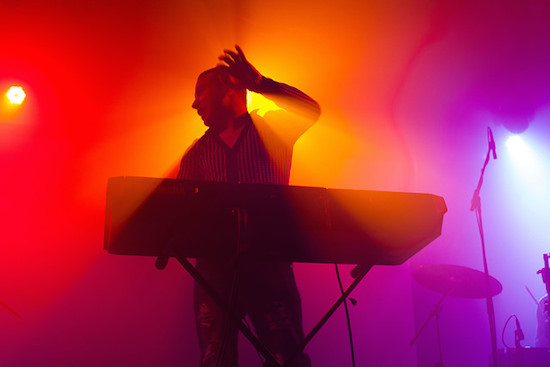
Underneath this year’s over-arching Un Tune theme, the subcategory of the "body" – the auditive aspect of communicating fluids rather than simply oozing them (read: sex) remained a little neglected. Arguably it wasn’t really until the penultimate night in YAAM (programmatically titled "endo", Greek for "inside") that this piercing hole was to be filled.
Embedded between the trans-human sounds of Born In Flamez and the inter-human courtship dance of EEK & Islam Chipsy, the Houndstooth-signed 18+ penetrate the cyber-human. A fluttery fan dissects the main floor, trying to breeze some air into the heated crowd. It sculpts two silhouettes apathetically swaying on stage, reflects the shimmering sweat drips on the ceiling. Meanwhile a sedated R&B bass meanders between low-leaning hips on the dancefloor and a constrained beat licks the gasping bodies clean before it all merges into an abstracted and unfamiliar form of intimacy. Sex takes place behind the stage and in front of it, most certainly not on it. It is the manifestation of hypersexuality in digital times, where bodies are reduced to an avatar-like status, but in its forlornness bear a very tactile vulnerability. .
As an intriguing opposite, the Polish RSS B0ys, traditionally veiled by their Slavic-ninja-hijabs, play in a slightly more den-like atmosphere, devouring audience and sound in equal measure. They seem to have travelled a long distance from their initial loose pattern of West African influences, making way for an uncompromising, pointillistic techno-trance, infused with a hollowed out industrial sound. It’s easy to imagine their set as a body, and a vision of the disjointed dolls by Surrealist erotomaniac Hans Bellmer springs to mind. Forms are shot to pieces and re-assembled, over and over again, until exceeding most points of recognition. Militaristic 4-to-the-floor-stomping ascends to a frantic point. If 18+ was an isolated wank to a glossy Hentai, the RSS B0ys are a quick fuck on a dirty gas station-toilet with some anonymous stranger.
Sonja Matuszczyk
Genre is but a state of mind

Nisennenmondai have devoured my brain. I’ve spent a large portion of the last couple of weeks listening to their brilliant LP N from last year, as well as their recent live rendition of it recorded at Cloud Hill, and as a result my head is constantly swirling with the same distinctive drum patterns and guitar shrieks that litter those records. Wandering across the busy main bar area in Astra, a familiar low rumble of guitar sucks me in to the main venue, inviting me to nestle obediently right at the front of the crowd. If you squint a little, you can just about make out the shadows of Chris Carter and Cosey Fanni Tutti lurking at the back of the stage, peering over a speaker stack that’s thrusting out huge repetitive rotor-like basslines, warming the crisp air that hangs above the crowd.
Masako Takada and Yuri Zaikawa deftly build a tower of sound that never crumbles, mutating seemingly endless repetition at the last possible moment. Drummer Sayaka Himeno is the most impressive thing I’ve seen all weekend, (bar four gigantic men being able to fit inside a single Berghain toilet cubicle) frenziedly pelting a cymbal for the entire set without relent, all while maintaining a furious walloping bass drum. I can’t shake the feeling that you could slip any of these tracks into techno set at 6am and nobody would bat an e-stretched eyelid. This is perhaps why the venue of Astra doesn’t quite seem to work as well as it should this evening. The crowd, burdened down with coats and scarves and heavy ten day festival legs, stay static; nodding their heads a little or tapping their feet rather than losing all inhibitions. It makes me consider the idea of experience/reaction again; and I can’t help but wonder whether, if this set had been in a more accommodating setting, even with the same lethargic crowd, that the resultant experiences, and indeed reactions, would have differed entirely. Sophie Coletta
They do a lovely brew at Berghain
The Quietus went to Berghain for a club night rather than a gig for the first time on the final Sunday of CTM. It was a 9–5 shift to sweat on to Perc and Stefan Rein. What’s odd is how most of what is written about the place goes on about exclusivity and debauchery, but it’s actually a beautifully democratic space that feels entirely autonomous and out of step with the real world outside. Yes, it is very fruity but in an unthreatening, not seedy, non-voyeuristic, opt-in-if-you-want it way. Why not dance with a bunch of tapsaff bears, and then revitalise with dropping an E, a blowie downstairs, an ice cream sorbet, a fuck on the sex swing, a trip to the generously proportioned toilets with your loved one, or one of the Panorama Bar’s excellent cups of tea?* The sexual side of Berghain feels just part and parcel of the whole experience and atmosphere, as much as the insanely good PA system that just powers you on dancing with no need for enhancement aside from said really pleasant non-lemony-Euro brew at lunchtime. While looking back over the past ten days it’s hard not to feel that it’s a bit of a shame that the walls of these venues can’t be broken down to allow in a wider audience, CTM and Berghain show once again that Britain is rather lacking compared to our continental European brothers and sisters. It’s a crying shame that England will never produce a place like that, at least until after we’ve had a bit of a Threads.
*One of these the Quietus did not do.

